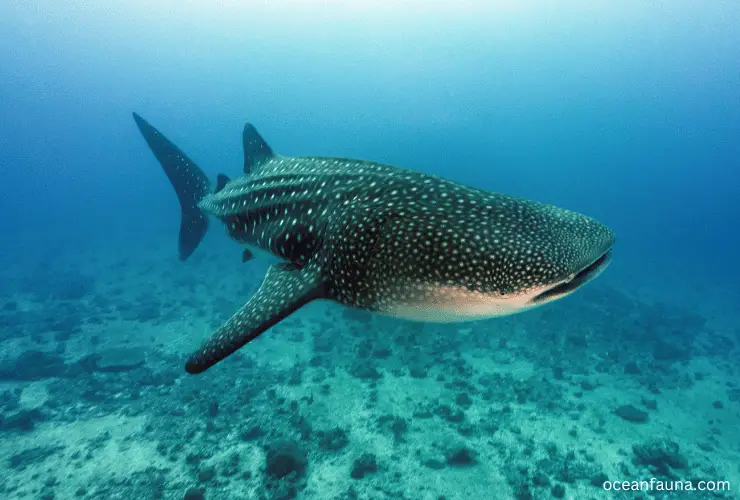Sharks, they’re the ultimate predators of the ocean, no doubt about it. But do you know how long do sharks live? Well, it actually depends on the shark species, their living conditions, habitat, and what they eat. Pretty interesting, right?
The lifespan of a shark can range from a few years to even several hundred. The smaller sharks, such as the bull shark, usually live up to 14-17 years, while the larger species, like Great White Sharks, may live up to 70 years or more in the wild.
In this blog post, I’ll cover the estimated average lifespans for some of the most popular species of sharks. I’ll also examine factors that can affect a shark’s lifespan and how long they can live in captivity compared to life in the wild.
Before you learn all the details about different sharks’ lifespan, have a look to the table below.
| Sharks Name | Lifespan |
| Great White Shark | 40-70 years |
| Bull Shark | 14-17 years |
| Spiny Dogfish | 25-100 years |
| Leopard Shark | 30 years |
| Hammerhead Shark | 25-45 years |
| Tiger Shark | 20-50 years |
| Whale Shark | 100 years |
| Basking Shark | 50 years |
| Common Thresher Shark | 19-50 years |
| Lemon Shark | 25-30 years |
| Nurse Shark | 25-35 years |
| Horn Shark | 25-50 years |
| Greenland Shark | 250+ years |
| Zebra Shark | 25-30 years |
| Mako Shark | 28-35 years |
| Port Jackson Shark | 30+ years |
| Angel Shark | 25-35 years |
| Salmon Shark | 20-30 years |
| Pyjama Shark | 21 years |
| Galapagos Shark | 24 years |
| Frilled Shark | 25 years |
| Blue Shark | 20+ years |
| Cat Shark | 25 years |
| Porbeagle Shark | 30 years |
| Wobbegong Shark | 25 years |
Factors That Affect the Lifespan of Sharks
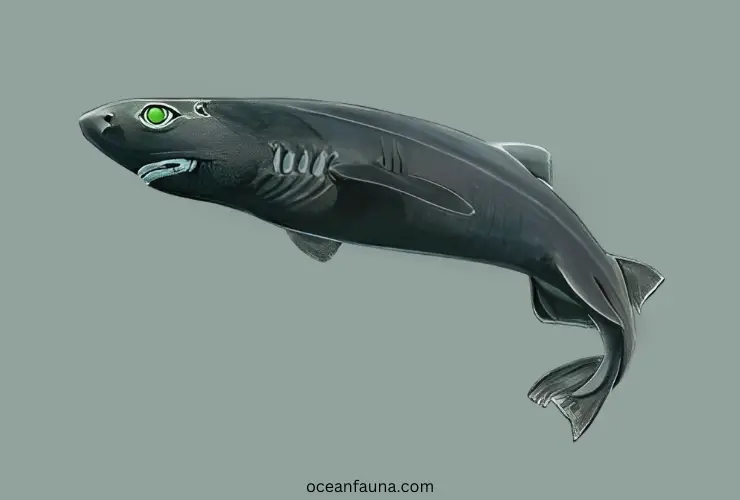
Sharks are one of the most ancient creatures on earth, having lived for more than 400 million years. They are apex predators that play an important role in marine ecosystems by maintaining the balance of the food chain.
Despite being an incredible species, they are vulnerable to various environmental and human-induced factors that affect their lifespan. Several factors influence the exact longevity of any given species. Here are the details-
Species-specific
The lifespan of sharks varies according to the different species. Some species, such as the dogfish shark and the spiny dogfish, can live up to 100 years, while others, such as the tiger shark and the hammerhead shark, have an average lifespan of approximately 30 years.
A shark’s lifespan largely depends on its size, reproductive rate, and habitat. For instance, species that have a longer gestation period and lower reproductive rates tend to have a longer lifespan.
Habitat
The habitat of a shark can impact its lifespan significantly. Sharks residing in deeper waters have been observed to live longer compared to those found in shallow areas near shorelines.
Additionally, sharks in captivity generally exhibit a shorter life expectancy than their counterparts in their natural environment.
Diet
Diet is another crucial factor that affects the lifespan of sharks. Sharks that feed on smaller prey, such as krill and plankton, tend to have longer lifespans than those that prey on larger mammals and fish. This is because the latter are more likely to accumulate toxins from their prey, affecting their health and lifespan.
In addition, sharks that feed on unhealthy prey are more prone to diseases that can reduce their lifespan substantially.
Climate Change
Climate change is having a major impact on the marine environment, also affecting sharks’ lifespan. As ocean temperatures rise, it causes changes in the distribution of their prey. In turn, this can cause a decline in the availability of food, which can affect the growth and reproduction of sharks.
Climate change also causes ocean acidification, which can affect the immune system and sensory organs of sharks and reduce their reproductive success.
Fishing and poaching
Overfishing and poaching of sharks have become major concern over the last few decades. Sharks are caught for their meat, fins, skin, and other body parts that are valuable in traditional medicine. This practice has significantly declined their populations, affecting their natural habitat and food sources.
It can also increase the competition for food and mating, which can lead to a shorter lifespan.
Pollution
Pollution of the marine environment is affecting the lifespan of sharks. Sharks absorb a variety of toxins from their prey and the surrounding water. These toxins can accumulate in their tissues, affecting their vital organs, reproduction, and immune system.
Polluted waters also cause diseases that can reduce the lifespan of sharks substantially.
How Long Do Sharks Live: Wild vs Captivity
Sharks demonstrate an extraordinary survival instinct in their natural habitat, perfectly adapting to their environment and thriving in the vast open ocean. Many shark species have been known to live for several decades, some even reaching an impressive age of 100. For example, the great white shark can live up to 70 years in the wild, while the Greenland shark can astoundingly live up to 500 years.
However, when these magnificent creatures are confined in captivity, the story takes a starkly different turn. Studies reveal that sharks in captivity have a significantly shorter lifespan than their wild counterparts.
This is primarily attributed to the drastic changes in their living conditions, which often fail to meet their natural needs, including sufficient swimming space, appropriate nutrition, and adequate water quality.
Research indicates that captive sharks can live anywhere from a few months to a few decades, with an average lifespan of about 5-10 years. This starkly contrasts their counterparts in the wild, highlighting the significant impact of captivity on their longevity.
Why do captive sharks have shorter lifespans?
One of the reasons for the difference in lifespan between wild and captive sharks is the stress caused by captivity. Sharks are apex predators and are used to being the dominant predator in their natural environment.
However, sharks are kept in confined spaces with limited room to swim and cannot live their natural hunting instincts when they are held in captivity. This can cause stress, leading to various health issues, including reduced immune function, loss of appetite, etc.
Another aspect that contributes to the shorter life expectancy of sharks in captivity is the quality and quantity of food provided. In the wild, sharks hunt for their prey, and their diet consists of various marine animals, providing them with all the required nutrients.
However, in captivity, sharks are fed frozen food, which does not provide all the necessary nutrients required for their survival. This results in malnourishment, which can cause a host of problems.
Furthermore, sharks are exposed to artificial lighting in captivity, which can disrupt their natural circadian rhythm. This can affect their feeding patterns, reproductive functions, and general health.
Sharks Lifecycle: How Do Sharks Live?
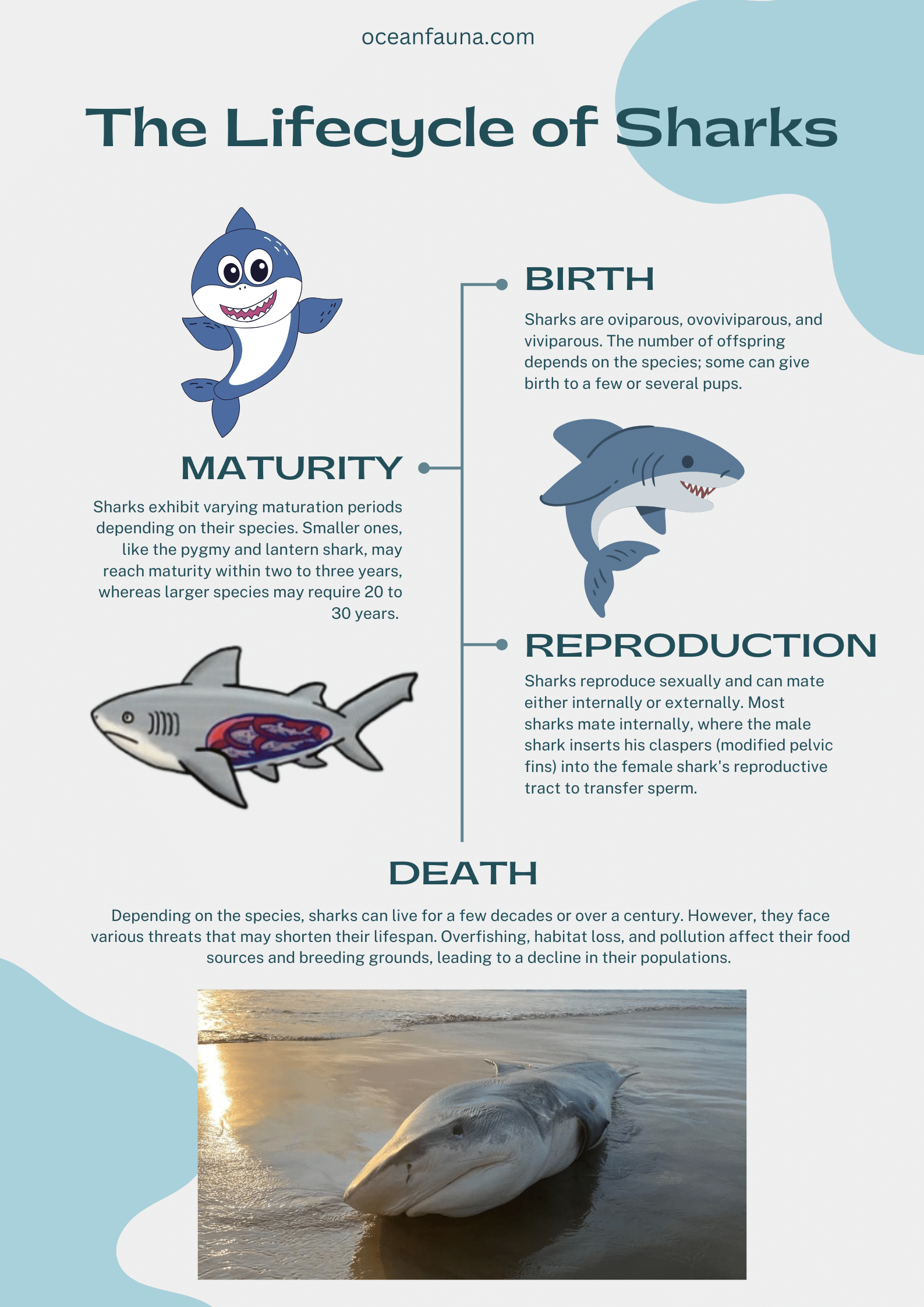
Sharks are fascinating creatures that have been around for more than 400 million years. These majestic animals have evolved over time to survive in various aquatic environments.
The lifecycle of sharks is a complex and intriguing process that involves various stages, from birth to maturity, reproduction, and death. Let us take a closer look at each phase in detail:
Birth: Are sharks oviparous, ovoviviparous, or viviparous?
Sharks are oviparous, ovoviviparous, and viviparous. Oviparous sharks lay eggs, such as the horn and bonnethead shark. Ovoviviparous sharks lay eggs inside their body and give birth to live young, such as Great White Shark, Tiger Shark and Dogfish Shark. And finally,- in case of viviparous sharks, pups develop inside the uterus as mammals do with placental connections between mother and pup. Lemon sharks, bull sharks and some other sharks fall in this category.
The number of offspring depends on the species; some can give birth to a few or several pups. Baby sharks are called pups, and they are born fully formed and ready to hunt. They have an egg yolk sac attached to their bellies, which provides them with nutrients for the first days of life. Pups are prone to predation and are vulnerable to other larger sharks until they reach maturity.
Maturity: When do sharks gain maturity?
Sharks exhibit varying maturation periods depending on their species. Smaller ones, like the pygmy and lantern shark, may reach maturity within two to three years, whereas larger species may require 20 to 30 years. Notably, male white sharks attain sexual maturity at approximately 26 years, while female white sharks require 33 years before they can reproduce.
Some species even achieve maturity after a century, such as the Greenland shark, which has been recently discovered to reproduce at around 150 years of age after gaining maturity.
When sharks reach maturity, their growth slows down, and they are prepared to mate and reproduce. Female sharks are equipped to bear offspring once they reach maturity, while male sharks are equipped to fertilize female sharks.
Reproduction: How do sharks reproduce?
Sharks reproduce sexually and can mate either internally or externally. Most sharks mate internally, where the male shark inserts his claspers (modified pelvic fins) into the female shark’s reproductive tract to transfer sperm. Once fertilized, the female shark carries the fertilized eggs or pups in her uterus.
Depending on the species, the gestation period lasts anywhere from a few months to several years. Some species, such as the sand tiger shark, have intrauterine cannibalism, where the strongest embryo consumes the weaker ones, leaving only a few pups to be born. Once born, the pups are independent, and the cycle starts again.
Death: How do sharks die?
Depending on the species, sharks can live for a few decades or over a century. However, they face various threats that may shorten their lifespan. Overfishing, habitat loss, and pollution affect their food sources and breeding grounds, leading to a decline in their populations.
Sharks are also hunted for their fins, meat, and other products, making them vulnerable to extinction. Some sharks also succumb to natural causes or disease and die, marking the end of their life cycles.
Lifespan Some Common Sharks Species

Check out the details on the lifespans of some of the most common sharks!
How long do Great White Sharks live?
The Great White Shark has a lifespan of around 40-70 years. These sharks are apex predators and have defended their place as the king of the ocean for millions of years. Great Whites can grow up to 20 feet in length and weigh over 5,000 pounds. They have a slow growth rate and reach maturity at around 15 years. After that, they have few natural predators and can live long lives.
How long do Bull Sharks live?
The Bull Shark has a comparatively shorter lifespan of 14-17 years. However, they can grow up to 11 feet and weigh over 700 pounds in this shorter time. They inhabit both salt and fresh water and are known for their aggressive behavior. Bull Sharks are also viviparous, meaning they give birth to live young, making them unique among sharks.
How long do Angel Sharks live?
The Angel Shark lives around 25-35 years. They are flattened and have a distinct shape, making them easily recognizable. Angel Sharks feed primarily on fish and crustaceans and are found in temperate waters. They are also threatened by overfishing and habitat destruction.
How long do Spiny Dogfish live?
Spiny Dogfish have a long lifespan of 25-100 years. They reach sexual maturity at around 20-35 years and give birth to live young. Spiny Dogfish, also known as rock salmon, are small, slender, and range from 18-24 inches in length. They primarily feed on small fish and squid and play a crucial role in the ocean’s food chain.
How long do Mako Sharks live?
The Mako Shark boasts a lifespan of 28-35 years. Known for their impressive speed, these sharks can reach velocities of up to 60 miles per hour. Highly sought-after by sport fishermen, Mako Sharks are also harvested for their meat and fins. With a potential length of up to 13 feet, these remarkable creatures can be found across the globe.
How long do Leopard Sharks live?
Leopard Sharks typically have a lifespan of approximately 30 years and can reach lengths of 5 to 6 feet. They are recognized for their distinctive pattern of black spots on their back, which resembles a leopard’s coat. These sharks pose no threat to humans and are commonly encountered in shallow water environments.
How long do Blue Sharks live?
The Blue Shark can live for more than 20 years. They hang out in temperate and tropical waters all over the world and can grow up to a whopping 12 feet long. These sharks mostly chow down on squid and fish, making them important in the marine ecosystem.
How long do Hammerhead Sharks live?
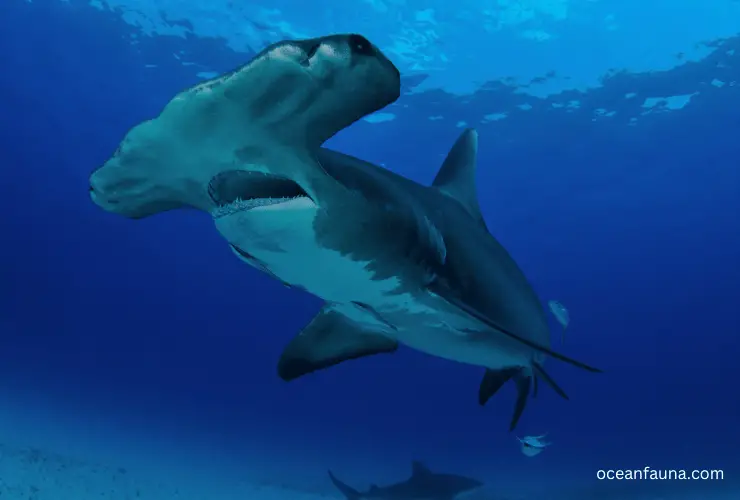
The Hammerhead Shark has a lifespan of 25-45 years. They are characterized by their elongated head, which has been likened to the shape of a hammer. Hammerhead Sharks are social creatures and often congregate in schools. They can grow up to 20 feet in length and are threatened by overfishing.
How long do Tiger Sharks live?
Tiger Sharks, these incredible creatures, can live up to 20-50 years and reach a length of 14 feet. They’re top predators, known for their aggressive nature and territorial behavior. Their diverse diet includes sea turtles, birds, and even other sharks. Oh, and they’re considered a bit dangerous to humans, responsible for quite a few shark attacks worldwide.
How long do Frilled Sharks live?
The Frilled Shark has a lifespan of around 25 years. They are found in deep-sea waters and can grow up to 6 feet in length. Frilled Sharks have a unique appearance, with long, frilled gill slits and needle-like teeth. They are considered rare and are not often seen by humans.
How long do Whale Sharks live?
The Whale Shark lives for about 100 years! They can grow up to a massive 40 feet, making them the biggest fish in the ocean. But don’t let their size fool you; these gentle giants mostly snack on plankton. Sadly, they’re in danger from overfishing because their fins are highly sought after.
How long do Basking Sharks live?
Basking Sharks are majestic creatures with a lifespan of approximately 50 years and reaching lengths of up to 33 feet. As filter feeders, they gracefully swim with their mouths agape, indulging in a feast of planktonic organisms. These magnificent giants can be found in temperate waters across the globe, adding to the allure of our vast oceans.
How long do Common Thresher Sharks live?
The Common Thresher Shark possesses a lifespan ranging from 19 to 50 years. It is characterized by a distinct tail, which it utilizes to immobilize its prey. Found in tropical and temperate waters, these sharks can reach lengths of up to 20 feet. Their diet mainly consists of fish and squid, rendering them significant predators within the ocean’s intricate food chain.
Which Shark Has the Longest Lifespan?
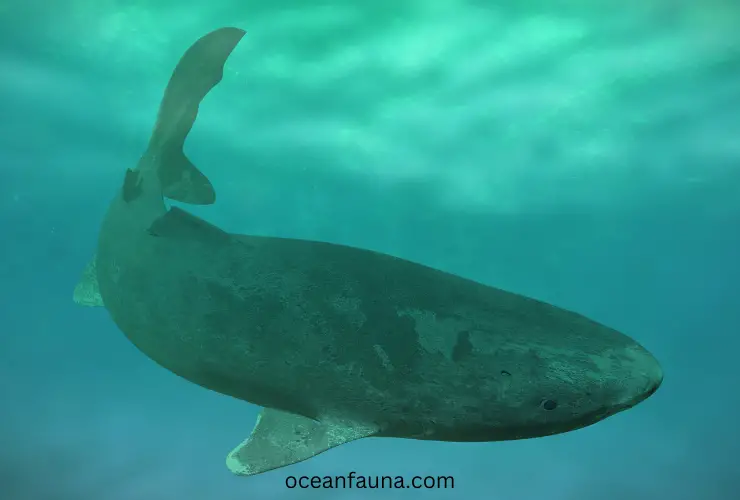
The shark with the longest lifespan is the Greenland shark, which is a cold-water species found in the North Atlantic and Arctic Oceans. This species is known for having an incredibly long lifespan, estimated to be between 250 and 500 years. This makes the Greenland shark the vertebrate species with the longest known lifespan, surpassing other long-living species such as the bowhead whale and the tortoise.
One of the reasons for the Greenland shark’s longevity is its slow growth rate, which is believed to be linked to its low metabolism. This species grows only a few centimeters per year and can take up to 150 years to reach sexual maturity.
Additionally, the Greenland shark’s adaptation to cold and deep waters may have also contributed to its long lifespan, as these conditions may reduce the metabolic rate and slow down the aging process.
Despite its impressive lifespan, the Greenland shark is still poorly studied, and much remains unknown about this species. Nevertheless, recent research has shed light on some interesting aspects of its biology. For example, scientists have found that the Greenland shark has a high concentration of trimethylamine oxide (TMAO) in its tissues, which may act as a natural antifreeze and allow the species to survive in sub-zero temperatures.
Conclusion
Now you have detailed information on the lifespan of various sharks, including all the factors that influence it. While some types of sharks may have longer lifespans than others, all species face threats from environmental damage and human activities such as overfishing and habitat destruction.
To ensure the long-term survival of these ancient creatures, we must protect their ocean habitats and reduce our impact on them. Taking action now can help ensure a future where sharks continue to thrive in our oceans.

